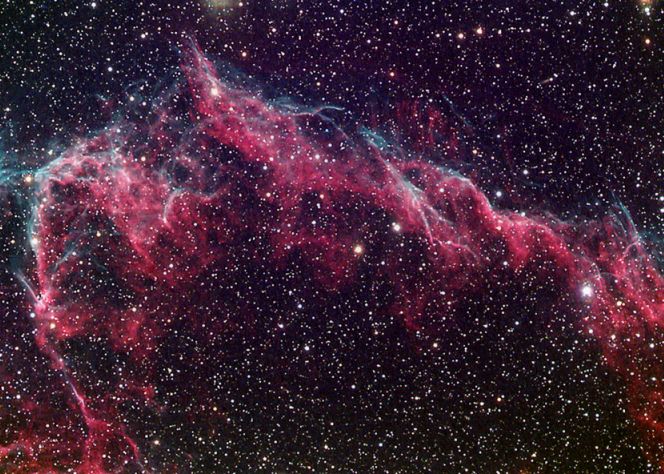
|
Credit & Copyright: Steve Mandel,
Hidden Valley Observatory
Explanation:
After 5,000 years, the gorgeous
Veil
Nebula is still turning heads.
Cataloged as NGC 6992, these glowing
filaments of interstellar
shocked gas are part of a larger spherical
supernova remnant known as the
Cygnus Loop or the
Veil Nebula -- expanding debris from a star which
exploded over 5,000 years ago.
This color digital image of a
bit
of the Veil has been processed
and enhanced to reveal stunning details in the diaphanous cosmic cloud.
Seen from our perspective against a rich Milky Way star field,
the Veil Nebula is
now
known to lie some 1,400 light-years away toward the
constellation Cygnus.
At that distance,
witnesses
to the original stellar explosion would have
seen a star in the heavens
increase in brightness to about -8 magnitude, roughly corresponding to
the brightness of the crescent Moon.
|
January February March April May June July August September October November December |
| ||||||||||||||||||||||||||||||||||||||||||||||||
NASA Web Site Statements, Warnings, and Disclaimers
NASA Official: Jay Norris. Specific rights apply.
A service of: LHEA at NASA / GSFC
& Michigan Tech. U.
Based on Astronomy Picture
Of the Day
Publications with keywords: Veil Nebula - NGC 6992 - supernova remnant
Publications with words: Veil Nebula - NGC 6992 - supernova remnant
See also:
- APOD: 2025 October 1 Á NGC 6960: The Witchs Broom Nebula
- APOD: 2025 June 9 Á Between Scylla and Charybdis: A Double Cosmic Discovery
- APOD: 2025 June 2 Á Veil Nebula: Wisps of an Ancient Supernova
- Supernova Remnant Cassiopeia A
- APOD: 2025 January 8 Á Supernova Remnants Big and Small
- APOD: 2024 September 18 Á The Mermaid Nebula Supernova Remnant
- APOD: 2024 September 4 Á NGC 6995: The Bat Nebula
